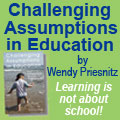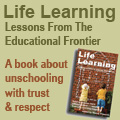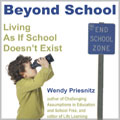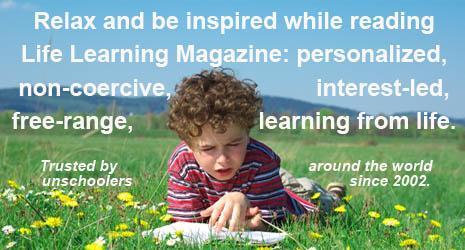|

Coercion, Compulsory Attendance, and Adultism
By Wendy Priesnitz
I’ve had a stone in my shoe for quite sometime now. I’ve tried to ignore it; I’ve begun and discarded a few pieces of writing about it; now I need to dump it out for good. It’s about how those of us dedicated to the idea of self-directed education (or Self-Directed Education as some prefer) define control and coercion.
I think I can safely say that we who believe in self-directed learning do so because we know that children learn best without coercion. But what does that actually mean? Does non-coercion reside across a spectrum? Is freedom age-specific?
For instance, there are schools – both independent and public – espousing self-direction that require compulsory attendance. Doesn’t that make them coercive by nature?
Coercion means persuading someone to do something by using threats or force. Compulsory means required by law or a rule; obligatory. Compulsion is coercive. So, for me, self-directed education is oxymoronic (not to mention ageist) if it is used within the context of a school that requires compulsory attendance. Benign jailers may be better than coercive ones, but they’re still jailers.
Activities can be described as “self-chosen,” or perhaps even be called “self-directed learning,” when they’re in the context of compulsory schooling. Or you can, in some schools, choose to do nothing. But I don’t see how it can be called a self-directed education if you have to be there because of insurance regulations, funding mechanisms, other legal circumstances, or some adultist bias or opinion about what’s good for you.
There are other potential contradictions as we apply non-coercion and respect to our lives with children. Where do nurturing, encouraging, guiding, and partnering stop and our sometimes-arbitrary rules kick in? Where is the line between our responsibility for younger people’s well-being and unnecessary control over them? Furthermore, if we believe in not trying to force children to learn, can we accept not trusting them to choose their own clothing, diet, and bedtime? Or managing their own use of electronics?
We all make choices based on our own beliefs, biases, and circumstances. Sometimes, we are blinded by our adult privilege and don’t even realize we’re making dubious or unnecessary choices for children. But, as we walk the path of following the principles of trust, respect, fairness, and non-coercion, let’s try not to cover up any contradictions, create excuses for them, or use euphemisms. Let’s be honest with ourselves and our children about our choices and the reasons for them. And then, with their help, we can try, where necessary, to make better ones.
Growth and change often require us to step outside our comfort zones. Asking ourselves the difficult but honest questions that drill down into our ideas and beliefs can be challenging.
The answers may change as we think about them, and as we grow in our awareness of our own ageism and what it means to trust children. But I think we owe it to ourselves and our children to consider these questions and to ensure our language accurately reflects reality as we are doing so.
Wendy Priesnitz is the editor of Life Learning Magazine. She is the mother of two adult daughters who learned without school, has been an advocate of self-directed education for over 45 years, and is the author of 13 books.
Copyright © Life Media
Privacy Policy
  
  

|

